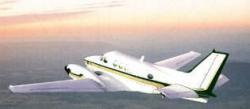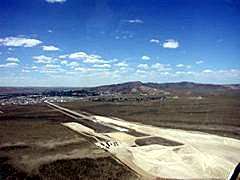Both Impacted Ridges On Final
 NTSB investigators looking into the
crash of an air ambulance on approach to the airport in Rawlings,
WY, last week say they're struck by the similarities between that
accident and another air ambulance mishap in Colorado in 2003. "We
are looking for common threads," said investigator David Bowling.
He told the Denver Post there could be an issue of pilot
preparation.
NTSB investigators looking into the
crash of an air ambulance on approach to the airport in Rawlings,
WY, last week say they're struck by the similarities between that
accident and another air ambulance mishap in Colorado in 2003. "We
are looking for common threads," said investigator David Bowling.
He told the Denver Post there could be an issue of pilot
preparation.
Consider: the aircraft that went down in Rawlings and the one
that crashed near Kremmling, CO, in 2003 involved the same company,
Mountain Flight Services. Both were Beechcraft King Air E-90s (file
photo of type, above). Both impacted ridges during snowstorm.
In the January 11th mishap on approach to Rawlings, pilot Tim
Benway, 35, flight nurse Dave Linner, 36, and nurse Jennifer Wells,
30, were killed. Paramedic Tim Baldwin, 35, survived the accident
and used his cell phone to guide rescuers to the crash scene.
In the March 19, 2003, accident, the entire crew survived.
Bowling is reportedly in charge of that investigation as well.
In that incident, paramedic Dotsy Gigliotti told the Rocky
Mountain News the pilot made an unusual approach to the runway at
Kremmling. "He saw white, but he thought it was fog. He forgot
about the butte."
Indeed, the NTSB finding of probable cause in that accident
stated:
 The pilot reported that he
maneuvered for a left hand downwind leg for landing from the east
to west. The pilot set up his downwind leg at 8,400 feet mean sea
level putting him at what would have been 1,000 feet above the
airport elevation of 7,411 feet.
The pilot reported that he
maneuvered for a left hand downwind leg for landing from the east
to west. The pilot set up his downwind leg at 8,400 feet mean sea
level putting him at what would have been 1,000 feet above the
airport elevation of 7,411 feet.
The pilot reported it was very dark and he could see the
airport, but could not see the terrain. The pilot reported that
suddenly he saw the ground. The airplane impacted the terrain and
came to rest. The pilot reported that the airplane was experiencing
no malfunctions prior to the accident. The airplane accident site
was on the snow-covered edge of a mountain ridge at an elevation of
8,489 feet.
An examination of the airplane's systems revealed no anomalies.
Published terminal procedures for the runway indicated high terrain
of 8,739 feet south-southeast of the airport. The published airport
diagram for the airport directs right traffic for the pattern to
runway 27.
The National Transportation Safety Board determines the probable
cause(s) of this accident as follows: the pilot's improper
in-flight planning and his failure to maintain safe clearance from
the high terrain. Factors contributing to the accident were the
high terrain and the dark night.
 In last week's mishap, Bowling said
pilot Benway activated the runway lights and was gear down when the
aircraft impacted the ridge. "There were low clouds, low visibility
and freezing rain," he told the Rocky Mountain News. "We don't know
what he saw. And that's what we are trying to determine."
In last week's mishap, Bowling said
pilot Benway activated the runway lights and was gear down when the
aircraft impacted the ridge. "There were low clouds, low visibility
and freezing rain," he told the Rocky Mountain News. "We don't know
what he saw. And that's what we are trying to determine."
Did Benway know what he was getting into at Rawlings (right)?
Yes, said Mountain Flight Services Administrator Cindy Maddox.
"There is no question but that the charts, the approach plates, all
of the information was available to him," she said. "I know a pilot
briefing was done on this one.
"We have attempted to do everything in our power to operate in a
safe and compliant manner," she said. "We will be absolutely
grateful to know any answers as to the cause of this tragic
accident."
 Classic Aero-TV: Remembering Bob Hoover
Classic Aero-TV: Remembering Bob Hoover ANN FAQ: Follow Us On Instagram!
ANN FAQ: Follow Us On Instagram! ANN's Daily Aero-Linx (05.15.24)
ANN's Daily Aero-Linx (05.15.24) ANN's Daily Aero-Term (05.15.24):Altimeter Setting
ANN's Daily Aero-Term (05.15.24):Altimeter Setting Aero-News: Quote of the Day (05.16.24)
Aero-News: Quote of the Day (05.16.24)





